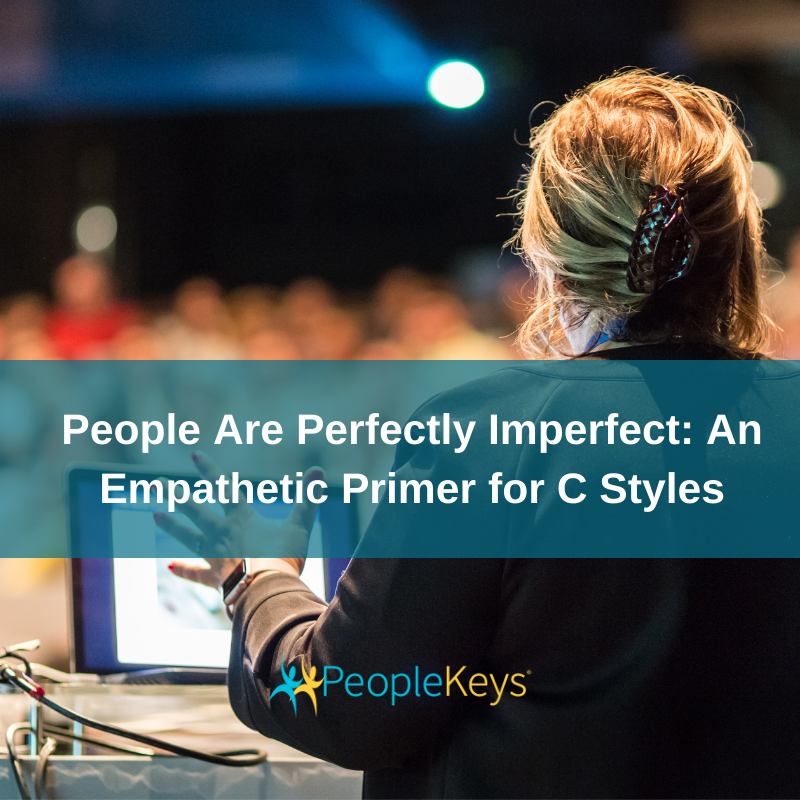
People Are Perfectly Imperfect: An Empathetic Primer for C Styles
Imagine you’re a keynote speaker on the way to a corporate training event. You’ve spent the past three weeks researching, compiling data, formatting presentation slides, and you feel confident about your ability to connect with your audience. You’ve got your briefcase, laptop, extra lapel mic, batteries, and flash drive with your presentation saved…check, check, and double check. Your support team sent you a confirmation of the venue and start time and arranged for transportation to allow for early arrival to conduct an audio/visual check before the event. Things are going as planned and running on time.
When you arrive at the venue, you make your way to the designated ballroom and ask the person sitting at the registration desk where speakers go for audio/visual checks. The individual replies, “I don’t know, I’m just confirming attendee registration.” You see someone walking into the conference room and you ask them the same question. They reply, “Oh, I think it’s somewhere backstage, but I don’t have access. You’ll have to find someone on the production team.” You look at your watch and note that you’re losing valuable rehearsal time. Frustration begins to build so you call your support team for back up, but no one answers the phone. You think to yourself, “Does anyone know what’s going on around here?” The last thing you need is stress before hitting the stage, but it seems that no one has any idea what’s going on. You decide to head to the venue information desk and just before you reach the counter, the fire alarm sounds and security guards begin ushering everyone outside like a heard of cats.
C styles, you almost certainly know the feeling that this level of disorganization brings. However, this next part is less about your reaction to the apparent chaos unfolding in this scenario and more about identifying your response options after feeling as though you’re have lost all control of the situation. When you agreed to this event you had high expectations, and now you’re left wondering if the time you spent preparing was for nothing. This isn’t what you had envisioned at all; it’s a complete and utter disaster! Time to pack up and go home. But not before finding out what’s next. You’re frustrated, but you spot a person carrying a clipboard and wearing a t-shirt that reads “production team” on the back and an event lanyard around their neck. BINGO! You make a mad dash to catch up with them to learn the fate of your time remaining.
“Life is full of surprises: new opportunities come up; that’s part of the fun – the adventure of life. The thing is, chaos doesn’t allow us to enjoy the adventure.” -Patrick Lencioni
When it comes to C styles dealing with chaos, people are generally the greater challenge, not the task. Knowing the person with the clipboard could be just as stressed over the events unfolding, there are some communication strategies to consider for best results.
Beware Emotional Stalemates with D Styles
Fast-paced and task-focused D styles are less likely to outwardly express positive or negative emotions, resulting in zero opportunity to connect. C styles struggling to communicate with D styles may initially attempt to use facts and figures to try and appease the D style, but when it comes to showing empathy, remember that emotions are fact and figure-less.
D styles do not prefer overanalyzing situations or being told how to solve problems, and they will not hesitate to respond abruptly or in an off-putting manner as an emotional defense mechanism. To better relate, consider being straightforward and focus on achieving future relationship goals as equal investors.
Here is an example of an empathetic statement to employ: “I understand the current circumstances may be out of your control. If possible, I would prefer to do an audio/visual check before the event if time permits. Can you assist?”
It opens communication channels in a direct manner to focus on the specific issue, connects on a task-focused level, and affords you the opportunity to understand the D style’s priorities as they’re navigating real-time challenges.
Beware Criticism in Place of Communication
Sometimes things just happen. They just do. There’s a fine balance for communicating and connecting when you’re upset about something that has occurred out of your control.
You know I styles are generally willing to come alongside in any scenario for support. Try this as a bridge to building a meaningful connection: “Wow, this was completely unexpected, your team is doing a great job managing through it. I’m a bit concerned I won’t have time to do an audio/visual check before my presentation. Can you direct me to a place where I can prepare?”
Affirmation is always a great start when communicating with I styles. Inviting them into a problem-solving scenario empowers them while you gain insight into their knowledge and resources.
Seek First to Understand, Then Correct.
There are times when the drive to state the obvious can become a detriment to relationships. When things go awry, sometimes it’s just so obvious to everyone involved that it goes without the need to highlight. Assume in this scenario that the production team is just not well prepared for this event.
Remember the phrase “two wrongs don’t make a right?” Consider this before launching a barrage attack of questions and criticism towards S styles to get to the bottom of the issue.
Remember, S styles strive to be supportive teammates and are generally great at planning and managing projects. In the event conflict arises, they need reassurance and may seek approval and consensus before gaining confidence to make changes or decisions.
To connect, try this approach: “I’m concerned my equipment may not be compatible with the venue equipment. I’d really appreciate the opportunity to check my audio/visual needs before hitting the stage. Will the production team have back up equipment in the event there is no time left after the fire alarm is cleared?” This gives the S style an understanding of your greatest concern and immediate need so they can begin working a plan to assist, because they want you to succeed.
C styles, if you haven’t picked up on the theme here, it’s that perfectionism doesn’t really exist. This is made obvious by all the imperfections we see and experience in our daily lives. Enjoy this short insightful video to dive deeper into the reality of perfectionism by researcher Brené Brown.
We all tend to want things in our lives, personally and professionally, to go a certain way. Remembering that people are imperfect, supportive, and understanding will help take you farther than you could ever go on your own. Learning how to navigate through all of life’s complexities helps makes us who we really are and if you use your skills correctly–or with some help from others–anything is possible!

Posted By: Lindy Lamielle
